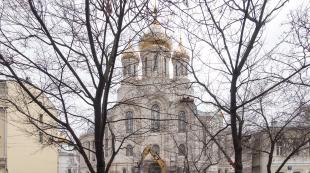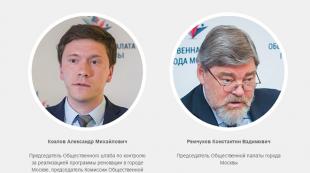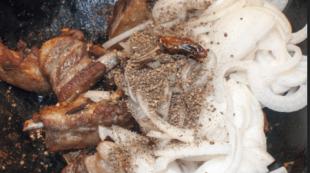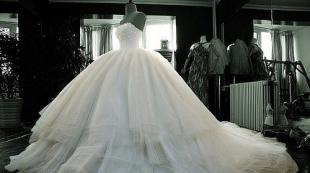Cathedral of the Nativity of the Virgin Mary of the Nativity Monastery. Russian Orthodox Churchfinancial and economic management
Muscovites who visited Trubnaya Square for the first time this year say with very different intonations: “Wow!” - The area has changed once again. In 2017, developers will present us with two seemingly dissimilar objects: a shopping center with the proud self-name “Central Market” and the Church of the New Martyrs of Russia in the Sretensky Monastery. The new buildings stand at the beginning and end of the boulevard that goes up the mountain, but when viewed from Trubnaya Square, the shopping center looks like the pedestal of a temple, combining with it not only aesthetically, but also due to the related circumstances of its appearance.
It’s funny to imagine that he spent the last quarter of a century on some mysterious cryogenic expedition, in complete isolation from news from his homeland. And then you arrive at today, knowing nothing about the fact that you died, or about the fact that Meadow was trampled, or about the fact that the pager is out of fashion. It seems to me that a careful look at the architecture would be enough to immediately understand a lot. She speaks more truthfully about time than crafty textual sources. The surroundings of Rozhdestvensky Boulevard have changed in a rather fatal way, but in order to appreciate these changes, we must remember what happened before them.
View of Rozhdestvensky Boulevard from Trubnaya Square. 2017 version
I first came here in the early 80s - back then it was still necessary to say “on Zhdanov Street”. My mother and I turned into a random corner of the Nativity Monastery - then it was still necessary to add “former”. There were apartments and amazing post-war Moscow comfort, already rare in those years: all these benches at the entrances, greenery, domino tables, dozens of gateway cats. We walked past the gates of the Architectural Institute; at the fountain, some young people were diligently smoking the sky. Mom did not know about the rich alcoholic traditions of the Moscow Architectural Institute and said: “If you study well, you will become the same.” Well, I did.
Having entered the institute, I firmly settled on Rozhdestvensky Boulevard, on the bench closest to the beer stall, so the changes that began in the mid-90s took place before my eyes. By that time, the number of cats in the gateways had diminished, but in general in this district Moscow was still that reserved. From Petrovka to Lubyanka the old city stretched, unchanged since the beginning of the 20th century. There were some knocked-out pieces in the streets, there were some discreet Soviet buildings, but overall the area was established, understandable and cozy. The author does not have the strength to once again enter into a debate on the importance of the predominance of historical buildings in a historical city and simply takes it as an axiom: it was very good here. As they say, if you wash it, you can live with it.
Market on Trubnaya Square, 1890–1910s
1 of 8Trubnaya Square, 1902
© M. Scherer/pastvu.com
2 of 8The mansion where the City District Committee of the RKSM was located in 1921–1922
3 out of 8Rozhdestvensky Boulevard, 1940–1947
4 out of 8Still from the film “I’m Twenty Years Old,” directed by Marlen Khutsiev, 1964
5 out of 8Trubnaya Square, 1982–1984
6 out of 8Beer stall on Rozhdestvensky Boulevard, 1993
© R. Tsekhansky/pastvu.com
7 out of 8“House with Caryatids” in Pechatnikov Lane. Still from the feature film “Iron Curtain”, director Savva Kulish, 1994–1996
8 out of 8But it was especially good at the beginning of Rozhdestvensky Boulevard, at the famous stall standing under huge, perhaps the most luxurious poplars in Moscow. While studying at the institute, it took a lot of work on the way from the metro not to miss the end of Rozhdestvenka and not wake up with your nose buried in a pub: it was so wonderful to live under these poplars, at the intersection of four boulevards.
There were also many cozy drinking spots in the former monasteries on the southern side of the boulevard, Rozhdestvensky and Sretensky. In my memory, no one danced breakdancing on the ruins of the chapel - it was more like romantic sketches from the cycle “Where the Motherland Begins.” For example, an unforgettable viewing platform on the roof of the current Rector's building - nearby there was a gap in the fence and a staircase down, straight to the stall. And you, of course, remember that at the kiosk they poured it strictly into the glass jars they brought: they always had to be obtained somewhere, including asking from apartment to apartment. So the guy, over whose room we used to have fun, always gave us a container and asked us to speak in a whisper during the hours when his children were sleeping. Lived according to conscience.

On March 15, the first service was held at the Church of the New Martyrs and Confessors of Russia on Lubyanka. They continue to finish painting and decorating it - for Easter
It was obvious that all this was just a lull, that the changes that we had been waiting for and hoping for were coming. But it was still assumed that the people who would begin to change the city would not be so stupid and greedy, and their fellow architects would not be so helpful and handy. The new buildings hid the best panoramic views: from Petrovsky Boulevard to the Nativity Monastery and from Rozhdestvensky Boulevard to the Petrovsky Monastery.
Rozhdestvenka’s prospects were monstrously cluttered by the “Legend of Tsvetnoy,” a property named after Naomi Campbell - remember, her oligarch husband once gave her an apartment in his new building? (in 2013 a couple. - Note ed.) Half of the old houses have disappeared, entire blocks of dusty but wildly interesting courtyards have disappeared, turning into a “solid spot” of office, residential and retail real estate. Walking along the street, you can only turn into the doors of various kinds of establishments: they are abundant and beautiful, but something is missing.
The main problem of Rozhdestvensky is the Central Market shopping center, which has become famous among the people under the name of the Dung Beetle. It was approved in 1996 as a glass café on the site of an old public toilet and construction began in 2004. It’s quite an allegory of time: the object obviously has no right to be here, since the Boulevard Ring is a monument of landscape gardening art, and the construction of permanent buildings across it is legally impossible. However, the facility gradually grew to 3300 sq. m, for its sake, one hundred meters of the boulevard were cut down, including those same poplars, and its construction has kept the boulevard in a state of severe devastation for 10 years, easily blocking half the lanes on the outer passage of the Boulevard Ring with a technical site.
2 out of 10
3 out of 10
4 out of 10
5 out of 10
6 out of 10
7 out of 10
8 out of 10
9 out of 10
10 of 10
The exact opening date of the “market” has not yet been announced, but the outside is finally finished. The object visually blocked the boulevard and enclosed Trubnaya Square, clearly not having a calling for this. The situation is saved as if by a cathedral standing on its roof, which rose three hundred meters from here last year. The new buildings are quite compatible stylistically - a kind of pseudo-traditional architecture, somewhat ridiculous in its demonstrative importance. At the shopping center there is a generous abundance of balusters, at the temple there is overflowing decorativeness of the facades. In fact, the cathedral is the same legalized unauthorized construction: major new construction in the security zone of the ancient monastery is, in principle, unacceptable. But the Sretensky Monastery has long existed according to separate rules.
Looking back to the 1990s again, it should be noted that in the Nativity and Sretensky monasteries the future arrived in different ways. Both of them had standard school buildings in their backs, built on the site of monastery gardens. Rozhdestvensky got rid of excess real estate in order to revive the garden, and Sretensky, using the powerful administrative resource of Vladyka, took the opposite tactic. He added an attic and converted the building of the school that had been expelled from the territory into a seminary, added three floors to the old empire-style cells, and placed several thousand square meters of utility space and a two-story parking lot under the new cathedral.
Orthodoxy also has its own pop, its own rock and its own underground. Father, they say, Tikhon is one of those stars who pack stadiums - it’s ridiculous to offer him a tour of the Moscow Palace of Culture
Looking at the cathedral from afar, it seems that the golden domes have become peeling. Only when you get closer do you realize that these are ornaments made of silver on gilding. The new building stands on a hill and at the same time is crushed in detail like a thing designed for viewing at close range. But there is no space nearby to admire the elaborate decoration, the old houses on the boulevard crowd the cathedral, and there is a fear that this is not the final stage of the formation of the ensemble.
house of Clara Kirchhoff. Muscovites know the unique “house with caryatids”, saved from death by an entrepreneur from Syktyvkar (private businesses on Truba also followed different paths into the future). The Kirchhoff house is a twin brother fused with it by a wall, whose ivy-covered courtyard was one of the best patriotic and educational centers in the area. The guys and I conventionally called it the heart of Moscow, and those who were ordered to take two and pull themselves up to the named place, as a rule, immediately understood which heart we were talking about. So it’s typical: 20 years later, the destruction is continued not by the mysterious LLC in crimson suits, but by the interregional public organization of historical and cultural heritage “Noble Union”. As they say, I’ll just leave it here - on the tablets of the capital’s local history.
Again, the guys and I once gathered the press, trying to draw attention to the disasters of the best Moscow boulevard, and I suggested drawing a dotted separation line across the road: here, where the courtyards and houses are, Moscow will be, and here, where the plastic office and the deeply respected Naomi, I don't understand why. But one smart girl said: “You see, Sasha, the problem is that Moscow is everywhere.” And when you understand that there is no magic line behind which you can hide from manure urban planning and everything else that each of us is not entirely to our liking, it becomes, oddly enough, easier.
It is one of the oldest convents for women in Moscow. The shrine is located at the intersection of Rozhdestvensky Boulevard and Rozhdestvenka Street.
Initially, the Nativity Monastery was located on the territory of the Kremlin in Moscow and bore the name of the Nativity of the Virgin Mary on the Moat. There is also an assumption that the monastery was actually originally created near Kuchkov Field on the banks of the Neglinnaya River, where the estates of Vladimir Andreevich Serpukhovsky were located.
In the 30s of the fifteenth century, the wife of Prince Vladimir the Brave, Elena Olgerdovna, named Eupraxia, took tonsure within the monastery walls. She donated several villages and villages for the improvement of the monastery. The princess lived here until 1452 and was interred, according to her will, in the monastery graveyard.

Architectural ensemble of the Nativity Monastery and further history
The one-domed cathedral in the name of the Nativity of the Blessed Virgin Mary was built of stone between 1501 and 1505. The religious building was built in the style of early Moscow architecture. The appearance of the shrine changed significantly after the great fire of 1547: for 150 years various constructions were carried out around it.
The history of the Nativity Monastery is connected with the name of Solomonia Saburova, the wife of Tsar Vasily III, who was forcibly tonsured here as a nun on November 25, 1525 and given the name Sophia. The queen stayed within these walls until she moved to the Intercession Monastery in the city of Suzdal.

On one summer day in 1547, during a fire on the territory of the monastery, many buildings were damaged, including the stone cathedral. It was restored quite soon, according to a vow made by the wife of Ivan the Terrible, Tsarina Anastasia Romanovna. The Tsar himself issued a decree on the construction of the St. Nicholas chapel in the southern apse of the Church of the Nativity.
In the 1670s, the Church of the Nativity became the burial place of representatives of the princely family of Lobanov-Rostovsky: their tomb was added to the main cathedral of the monastery, on the eastern side. Already in the nineteenth century, a second floor rose above it to house the monastery sacristy.

In the period from 1676 to 1678, a stone church was erected in the name of St. John Chrysostom, as well as a refectory and several chapels in the name of Saints Nicholas the Pleasant, Demetrius of Rostov and Philaret the Merciful. The funds were allocated by Princess Fotinia Ivanovna Lobanova-Rostovskaya.
With her money, a stone fence with four turrets was built around the monastery in 1671.
In the period from 1835 to 1836, a bell tower with a church consecrated in the name of the Hieromartyr Eugene, Bishop of Kherson, was erected above the monastery’s Holy Gates. The project was carried out by the architect Nikolai Ilyich Kozlovsky, and the funds were allocated by S.I. Shterich.
Three-story cells were built already at the beginning of the twentieth century. Classes of the parochial school were also located there.

The reconstruction of the church in the name of John Chrysostom was carried out according to the design of the architect Pyotr Alekseevich Vinogradov in 1903-1904. The same architect built a temple in the name of the Kazan Icon of the Mother of God in 1904-1906.
At the Nativity Monastery, before the Bolsheviks came to power, there was a shelter for orphan girls.
The monastery was closed in 1922, after which it was thoroughly looted. Only the silver vestments removed from the images made it possible to export about 17 pounds of silver. The icons from the monastery churches, however, were first moved to the Church of St. Nicholas the Wonderworker in Zvonary, and only then to the Znamensky Church in Pereyaslavskaya Sloboda.
During the years of Soviet power, the premises were given over to scientific, educational, and office institutions. Communal apartments appeared in the cells. Interestingly, some former nuns were still allowed to stay in place, and two of them lived within these walls until the end of the 70s of the last century.
The monastery necropolis was destroyed, as well as part of the walls surrounding it.

In 1974, the Nativity Stauropegic Convent was transferred to the jurisdiction of the Moscow Architectural Institute, after which the “Museum-Reserve of Ancient Russian Art and Architecture” was opened here. After restoration work was completed, an archive of one of the Moscow research institutes was created in the Nativity Cathedral.
Dear parishioners of the Sretensky Monastery!
On October 3, 2012, an open competition for the preliminary design of the Church of the New Martyrs and Confessors of Russia on Blood, in Lubyanka, was announced and ended on December 10, 2012.
The need for a new, spacious church in our monastery has been long overdue: who, if not you, knows, that often many parishioners cannot fit in the only surviving cathedral and are forced to listen to the broadcast of the service while standing on the street.
The goals and objectives of the competition emphasized the following requirements for the future project.
“The temple should reflect the idea of the House of God, traditional for Russian church architecture, as well as the feat and triumph of the spiritual victory of the New Martyrs of Russia.” This became the most important task for designers.
We expected a creative solution that could express the idea of the heavenly triumph of the New Martyrs, carry within itself the joy and light of the victory of the Resurrection of Christ, the Church of Christ over the evil of this world, Eternal Life over death. Built to mark the centenary of the beginning of the tragic events of the past century, this cathedral should be precisely the Temple-Monument to the victory of the Lord Jesus Christ and His holy disciples -.
There were also indispensable technical aspects in the competition task.The temple must be spacious: ideally for two thousand people.
Another requirement is to provide for open-air services during the warm season, as is done, in particular, in the Pskov-Pechersky Monastery, with a special gathering of people.
Due to the particularly cramped area of the monastery, the designers had to take into account the possibility of a religious procession along the gallery around the temple.
Also, due to the extremely small territory of the Sretensky Monastery (and it is indeed the smallest and at the same time the most populated monastery in Moscow - 42 monks and novices and 200 students of the Sretensky Theological Seminary live here), we asked the designers to provide the maximum number of additional premises: for sacristies, workshops, other technical services, as well as for the Sretensky Sunday school, an educational and catechetical center for adults and a monastery publishing house, the building of which will be demolished.
Finally, underground premises are needed for the vehicles of the monastery services.
All these economic problems had to be solved without damaging the image of the temple.
The competition brief also stated that the architecture of the temple should be made in Russian traditions (Moscow, Vladimir-Suzdal, Novgorod, Pskov, neo-Byzantine), but may also contain elements of modern forms and designs.
48 projects were submitted to the competition. Many of them deserve the most serious attention from anyone interested in church architecture. Some of the works are truly talented, traditional in the best sense of the word. On behalf of His Holiness the Patriarch, I, as the vicar of the monastery, sent letters of gratitude to everyone who took part in this creative competition. And three winners were awarded in accordance with the terms of the competition.The jury of the competition, in addition to two representatives of the Sretensky Monastery, included famous Moscow architects and art historians.
Below we publish all the submitted projects: readers will be able to correlate the creative and technical tasks formulated by the terms of the competition with the creative solutions proposed to us.
After viewing and discussions, the jury selected three projects, and among them was the winning project presented by D. Smirnov’s workshop. The decision of the jury was soon approved by the Rector of our monastery, His Holiness Patriarch of Moscow and All Rus' Kirill.What made this work stand out from all the others?
The main task of the competition was to create the image of the Temple-monument, the Temple-the triumph of the victory of Christ and His disciples, the New Martyrs, and this is what, in the opinion of the jury, the authors of the winning project did better than others.
The image of the temple presented is unusually bright and majestic. The fact that the authors erected the temple on a stylobate pedestal visually emphasizes the idea of the monument.
We were truly pleased with how the authors of the project were able to find an eschatological image of the victory of the Church, the image of the Heavenly City, the New Jerusalem, in the center of which is the Lamb - our Lord Jesus Christ in the triumph of His victory.And I saw a great white throne and Him sitting on it, from whose face heaven and earth fled, and no place was found for them. (Rev. 20:11). The artists embodied this idea by placing iconographic images of the Savior on the throne surrounded by the New Martyrs on the outer wall of the temple. For some reason, by the way, this is precisely what caused the harshest criticism, even reproaches for modernism, although we can see exactly this solution on the facade of the main cathedral of the Pskov-Pechersky Monastery, and in this case this artistic parallel seems significant to us, since The Moscow Sretensky Monastery has a special spiritual relationship with the Pskov-Pechersky Monastery.
 |
Together with the internal balconies, the temple will accommodate two thousand worshipers, which corresponds to the technical specifications. And at the same time, the cathedral is designed in such a way that, while standing on a par with street houses, it does not face the line of Rozhdestvensky Boulevard (unlike most of the presented projects) - which, given the high density of buildings, still makes it possible to look at it from considerable distance.
Unfortunately, not all projects provided for the possibility of holding open-air services. When giving this task, we expected that a balcony or small area would be designated for such a service, but the authors of the winning project proposed a much better option.During a particularly crowded service, the gallery on the stylobate becomes an altar - a portable Altar is installed here - and the parishioners are located in the monastery courtyard.
The solution, in my opinion, is very simple, elegant, successful and at the same time practical. And the icons of the Savior and New Martyrs on the internal facade of the temple will remind of the iconostasis, creating the correct image of worship.
It is convenient to conduct religious processions along the stylobate gallery without going out onto Rozhdestvensky Boulevard and without interfering with city traffic (which would be inevitable if we accept the project of directly connecting the walls of the temple to the city street).
Finally, in the spacious stylobate, which serves as the artistic and architectural pedestal of the Temple-Monument, we will be able, incomparably better than in the three-story extensions proposed by other projects, to accommodate an educational center with a lecture hall, a Sunday school with classes, and numerous technical services, a publishing house and even several lecture halls for our seminary.We do not yet know what the material of the external and internal decoration of the temple will be, what the technique of images will be, what specific subjects of the bas-reliefs dedicated to the New Martyrs will be on the facades of the stairs. All this is in the process of the most serious work and discussions.
As for another most important component of the project - the need to create an architectural concept for the new temple in conjunction with the existing buildings in the monastery - here I give the floor to the professionals who spoke on this topic.
Academician V.D. Shmykov, architect-restorer, head of the architectural design workshop of the Federal State Unitary Enterprise “Institute “Spetsproektrestavratsiya”, full member of the Academy of Architectural Heritage: “The architectural and artistic image created by the authors contains the idea of the spiritual triumph of the New Martyrs in the name of Christ and the Orthodox Church, corresponds to the high spirituality of the Russian Orthodox people and supports the high monastery status. At the same time, it fits well into the existing urban planning situation and the existing surrounding historical buildings.”
Professor of Moscow Architectural Institute Timur Bashkaev: “In general, this is an impressive work, accurately reflecting the needs and self-awareness of the modern Church, but requiring careful verification of the urban planning and space-planning solutions of the complex while maintaining the bright author’s style of the façade solutions.”
I appeal to our parishioners with a request for prayers, so that the Lord will bless this endeavor and allow the construction and improvement of the temple to be completed on time - by February 2017.
Below we present photographs of all projects participating in the competition.
 |









